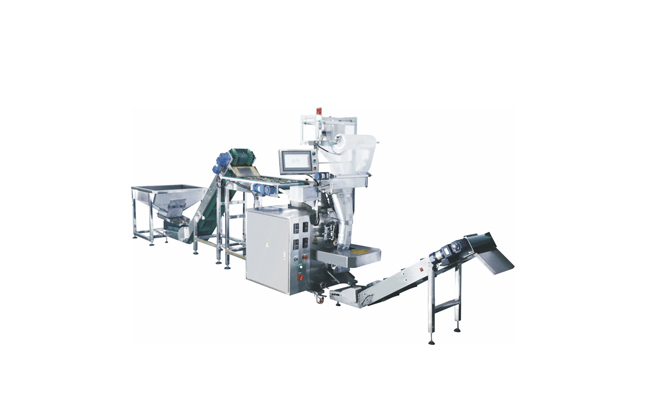
Date | 2023-05-12 01:35:35
Introduction
In today's fast-paced manufacturing industry, optimizing packaging processes is crucial for efficient production and cost-saving measures. The semi-automatic packing machine has emerged as a game-changer, offering advanced technology and enhanced productivity. This article delves into the technical aspects of the semi-automatic packing machine and explores its benefits for businesses.
Overview of the Semi-automatic Packing Machine
The semi-automatic packing machine is a versatile and intelligent device designed to streamline packaging operations. It combines manual input with automated processes, providing a cost-effective solution for small to medium-scale enterprises. This machine offers the convenience of automation while still allowing operators to have control and flexibility during the packaging process.
Key Features and Functionality
User-friendly Interface: The semi-automatic packing machine boasts a user-friendly interface, making it easy for operators to navigate and control. The intuitive control panel allows for quick adjustments and customization according to specific packaging requirements.
Precise Packaging: With advanced sensors and programming, the machine ensures precise packaging results. It accurately measures and dispenses the right amount of material, minimizing waste and maximizing efficiency.
Versatility: The semi-automatic packing machine accommodates a wide range of packaging materials, such as bags, cartons, bottles, and more. Its adjustable settings enable operators to adapt the machine to different product dimensions and shapes.
Integration Capabilities: The machine can be seamlessly integrated into existing production lines, enhancing overall operational efficiency. It can connect with other equipment, such as conveyor belts or labeling machines, for a smooth and synchronized packaging process.
Safety Features: Safety is paramount in any industrial setting. The semi-automatic packing machine incorporates safety measures, such as emergency stop buttons and protective enclosures, ensuring the well-being of operators and minimizing accidents.
Benefits of the Semi-automatic Packing Machine
Increased Productivity: By automating repetitive packaging tasks, the machine significantly increases productivity. It reduces manual labor requirements, allowing operators to focus on more complex tasks and improving overall output.
Consistency and Quality Control: The machine ensures consistent packaging results, reducing the risk of errors or variations. This consistency enhances product quality and customer satisfaction, leading to a positive brand reputation.
Cost Savings: The semi-automatic packing machine optimizes material usage and reduces waste, resulting in cost savings for businesses. Its efficient operation minimizes the need for rework or product replacement, further reducing expenses.
Time Efficiency: With its automated processes, the machine speeds up the packaging workflow. It reduces packaging time, enabling businesses to meet tight deadlines and fulfill customer orders promptly.
Flexibility and Adaptability: The machine's adjustable settings and compatibility with various packaging materials provide businesses with the flexibility to package different products efficiently. This adaptability proves beneficial when handling a diverse range of items.
Conclusion
The semi-automatic packing machine revolutionizes packaging processes by combining automation with operator control. Its advanced features, functionality, and compatibility make it an invaluable asset for businesses seeking efficiency, productivity, and cost savings. By investing in this technology, manufacturers can streamline their operations and stay ahead in today's competitive market.Optimization and Maintenance of the Semi-automatic Packing Machine
To maximize the benefits of a semi-automatic packing machine and ensure its long-term functionality, it is essential to focus on optimization and maintenance. Here are some key aspects to consider:
Regular Calibration: Calibrating the machine at regular intervals is crucial for maintaining accuracy and consistency in packaging. This process involves verifying and adjusting the machine's settings, such as weight measurement and material dispensing, to ensure optimal performance.
Training and Skill Development: Providing adequate training to operators is vital for utilizing the machine effectively. Operators should be familiar with the machine's features, controls, and troubleshooting techniques. Ongoing skill development programs can further enhance their expertise, enabling them to operate the machine efficiently and address any technical issues that may arise.
Preventive Maintenance: Implementing a preventive maintenance schedule is essential to keep the semi-automatic packing machine in optimal condition. This includes routine inspections, cleaning, and lubrication of key components. Regular maintenance minimizes the risk of breakdowns, extends the machine's lifespan, and reduces downtime.
Spare Parts Inventory: Maintaining an inventory of critical spare parts ensures quick replacement in case of component failure. Collaborating with the machine manufacturer or authorized suppliers can help businesses acquire genuine spare parts and minimize the time required for repairs.
Monitoring and Analytics: Leveraging technology for machine monitoring and data analytics can provide valuable insights into performance trends, efficiency, and potential areas for improvement. This data-driven approach helps identify bottlenecks, optimize processes, and enhance overall productivity.
Safety and Compliance: Ensuring compliance with safety regulations and industry standards is paramount. Regular safety checks, operator training on safety protocols, and adherence to maintenance guidelines contribute to a safe working environment and prevent accidents.
Continuous Improvement: Encouraging feedback from operators and gathering insights from the production team can lead to continuous improvement of the machine's performance. Identifying areas for enhancement and implementing relevant modifications or upgrades can result in increased efficiency and productivity over time.
Conclusion
The optimization and maintenance of a semi-automatic packing machine are crucial for reaping the full benefits of this advanced technology. By implementing calibration, training programs, preventive maintenance, and data-driven analysis, businesses can enhance productivity, ensure consistent packaging quality, and prolong the machine's lifespan. Emphasizing safety and compliance, while fostering a culture of continuous improvement, will help organizations stay ahead in the ever-evolving packaging industry.
